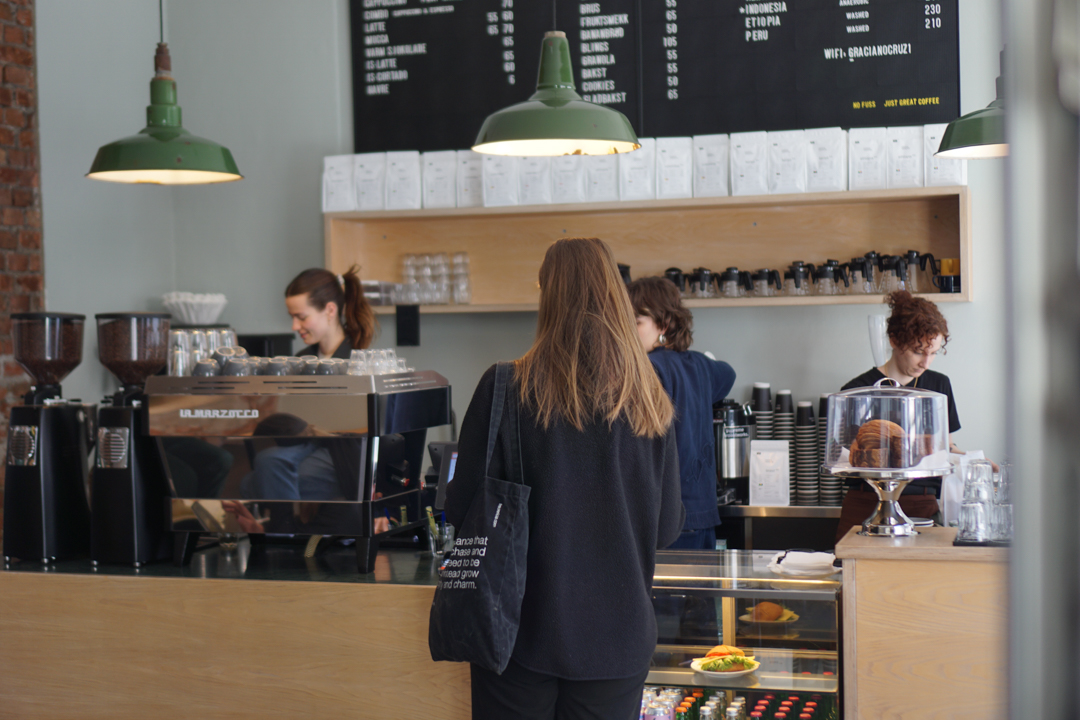For a world-renowed café such as Supreme Roastworks, it is almost hard to believe that everything can be so simple. The interior is designed in the utmost minimalistic style: white walls, black furniture, surrounded by wooden benches against the wall and counter seating facing large glass windows.
All milk-based coffee drinks are served in simple drinking glasses, while the hand-brews come in Hario glass servers and ceramic coffee cups. Yet this is how far the facade of simplicity goes: once you take a sip of the coffee, you immediately understand why this is one of best cafés in Oslo.
V60 pour over Caffè latte


World champion
The men behind Supreme are Odd-Steinar Tøllefsen and Magnus Lindskog, a partnership that stretches back to early 2000s. Odd-Steinar Tøllefsen is four times Norway’s national champion in coffee brewing and the 2015 World Brewers cup champion, the third world champion in Norway’s history. The other two are Robert Thoresen, owner of Kaffa roastery, Java and Mocca, and Tim Wendelboe, who runs the shop named after himself, arguably one of the most famous cafés in Oslo.

There is actually a deep connection between Odd-Steinar Tøllefsen and Robert Thoresen. Tøllefsen’s business partner Magnus Lindskog used to work at Java and Mocca. Nudged by Tøllefsen, Lindskog partnered up with Joar Christoffersen, who also worked at Mocca at the time, and opened Supreme as a roastery in a garage in Oslo’s Torshov area in 2007.
In 2013, the up-and-coming roastery moved out of the garage and opened a coffee bar in Oslo’s young and vibrant Grünerløkka area, where the shop remains today. Tøllefsen was so deeply invovled in the shop’s business decisions that eventually he became a co-owner a year earlier. It is also here his legendary coffee career took off.
Having worked for almost a decade as a photographer for some of Norway’s biggest newspapers and media companies, Tøllefsen was hardly interested in coffee when he was 40 years old. It was on a business trip to Napoli where he for the first time dicovered the charm of coffee. Coming back to Norway, he started hanging out at Java and Mocca, which were one of the first specialty cafés in Oslo at the time.
“I went there only to have coffee brewed by him (Magnus Lindskog). One notices the difference with different people making the coffee…If Magnus was not at work, I would just drop coffee that day…” said Tøllefsen in an intervew in 2016 with Aftenposten, one of Norway’s largest newspapers.
Lindskog introduced Tøllefsen to specialty coffee, but it was Tøllefsen’s newly kindled passion for coffee and persistence that finally knocked open the door to success and fame. After working as a full-time barista and intensive training for two years, Tøllefsen entered the World Brewers Cup and ended up ranking 4th in 2014. It was then “I realised that victory is within my reach,” Tøllefsen said in the interview. One year later, he took home the trophy, 10 years after Tim Wendelboe.
The championship has attracted worldwide attention. The somewhat anonymous coffee bar at Grünerløkka has instantly become a popular touristic attraction.
“Coffee tourists do not generate much economic benefits, but the reputation in the market does mean something,” said Magus Lindskog in an interview in 2018 with kaffe.no, a Norwegian trade media.
According to the shop, only roughly 10% of their visitors are tourists while local regulars make up 90%. To have a cup of coffee brewed and served by a world champion does help with promotion.




“No fuss, just great coffee”
For years, Supreme has upheld the philosophy of “no fuss, just great coffee”. This certainly offers an explanation of the deliberate simplification of everything else, as a way to avoid the so-called “decision fatigue”, in the same way that Steve Jobs wore the same outfit everyday.
What really matters, however, is the efforts behind the seemingly effortless facade. When asked the reason for Supreme’s popularity, Tøllefsen famously answered: “Natural beans, and the world’s best black coffee. Naked and honest, just pure raw material brewed with pure Norwegian water.”
In fact, Tøllefsen cannot place a stronger emphasis on water. “Nothing can be left to chances…that’s why I always carry (60 liters of) water as extra baggage when I travel to Japan, China and Italy,” Tøllefsen said in his interview with Aftenposten.
Tøllefsen’s championship has, to a certain extent, also changed the industry’s views about natural beans. For a long time, natural beans have been regarded as second-rate. During the 2015 competition, Supreme was the only team that chose to use natural beans. Two years later, however, everyone used natural beans.

Tøllefsen’s own personal favourite is Ethiopian natural beans, according to the Aftenposten interview. The natural coffee is made by drying the berries without de-pulping them, which result in a spontaneous fermentation, and one can achieve a sweetness and a fruity taste as a biproduct of this process.
Water, beans, the ratio between the two, the temperature, the brewing techniques, to just name a few—when you are aiming to make a perfect cup of coffee, there are so many things that can go wrong. Yet despite all the difficulties, Tøllefsen’s biggest secret is to “keep it simple, and as good as possible”, so that you can make the same brew “over and over again”. Indeed, it is this single-minded concentration, together with the countless repititions, that made what’s so difficult appear so simple.
